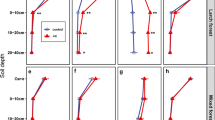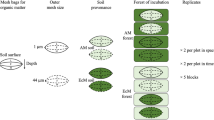Abstract
Forest canopy herbivores are known to increase rates of nutrient fluxes to the forest floor in a number of temperate and boreal forests, but few studies have measured effects of herbivore-enhanced nutrient fluxes in tropical forests. We simulated herbivore-induced fluxes in a tropical rainforest in Puerto Rico by augmenting greenfall (fresh foliage fragments), frassfall (insect feces), and throughfall (precipitation enriched with foliar leachates) in replicated experimental plots on the forest floor. Background rates of greenfall and frassfall were measured monthly using litterfall collectors and augmented by adding 10× greenfall or 10× frassfall to designated plots. Throughfall fluxes of NH4, NO3 and PO4 (but not water) were doubled in treatment plots, based on published rates of fluxes of these nutrients in throughfall. Control plots received only background flux rates for these compounds but the same minimum amount of distilled water. We evaluated treatment effects as changes in flux rates for NO3, NH4 and PO4, measured as decomposition rate of leaf litter in litterbags and as adsorption in ion-exchange resin bags at the litter–soil interface. Frass addition significantly increased NO3 and NH4 fluxes, and frass and throughfall additions significantly reduced decay rate, compared to controls. Reduced decay rate suggests that nitrogen flux was sufficient to inhibit microbial decomposition activity. Our treatments represented fluxes expected from low–moderate herbivore outbreaks and demonstrated that herbivores, at these outbreak levels, increase ecosystem-level N and P fluxes by >30% in this tropical rainforest.



Similar content being viewed by others
References
Belovsky GE, Slade JB (2000) Insect herbivory accelerates nutrient cycling and increases plant production. Proc Natl Acad Sci USA 97:14412–14417
Binkley D, Matson P (1983) Ion exchange resin bag method for assessing forest soil nitrogen availability. Soil Sci Soc Am 47:1050–1052
Binkley D, Aber J, Pastor J, Nadelhoffer K (1986) Nitrogen availability in some Wisconsin forests: comparisons of resin bags and on-site incubations. Biol Fert Soils 2:77–82
Chapman SK, Hart SC, Cobb NS, Whitham TG, Koch GW (2003) Insect herbivory increases litter quality and decomposition: an extension of the acceleration hypothesis. Ecology 84:2867–2876
Christenson LM, Lovett GM, Mitchell MJ, Groffman PM (2002) The fate of nitrogen in gypsy moth frass deposited to an oak forest floor. Oecologia 131:444–452
Classen AT, Hart SC, Whitham TG, Cobb NS, Koch GW (2005) Insect infestations linked to changes in microclimate: important climate change implications. Soil Sci Soc Am 69:2049–2057
Coleman DC, Crossley DA Jr, Hendrix PF (2004) Fundamentals of soil ecology. Elsevier, San Diego
Coley PD, Aide TM (1991) Comparison of herbivory and plant defenses in temperate and tropical broad-leaved forests. In: Price PW, Lewinsohn TM, Fernandes GW, Benson WW (eds) Plant–animal interactions: evolutionary ecology in tropical and temperate regions. Wiley, New York, pp 25–49
Coley PD, Barone JA (1996) Herbivory and plant defenses in tropical forests. Annu Rev Ecol Syst 27:305–335
Cuevas E, Lugo AE (1998) Dynamics of organic matter and nutrient return from litterfall in stands of ten tropical tree plantation species. For Ecol Manag 112:263–279
Distefano JF, Gholtz HL (1986) A proposed use of ion exchange resins to measure nitrogen mineralization and nitrification in intact soil cores. Commun Soil Sci Plant Anal 17:989–998
Edmisten J (1970) Soil studies in the El Verde rain forest. In: Odum HT, Pigeon RF (eds) A tropical rain forest. US Atomic Energy Commission, Oak Ridge, pp H-79–H-87
Enriquez S, Duarte CM, Sand-Jensen K (1993) Patterns in decomposition rates among photosynthetic organisms: the importance of detritus C:N:P content. Oecologia 94:457–471
Fonte SJ, Schowalter TD (2004) Decomposition of greenfall vs. senescent foliage in a tropical forest ecosystem in Puerto Rico. Biotropica 36:474–482
Fonte SJ, Schowalter TD (2005) The influence of a neotropical herbivore (Lamponius portoricensis) on nutrient cycling and soil processes. Oecologia 146:423–431
Frost CJ, Hunter MD (2004) Insect canopy herbivory and frass deposition affect soil nutrient dynamics and export in oak mesocosms. Ecology 85:3335–3347
Frost CJ, Hunter MD (2007) Recycling of nitrogen in herbivore feces: plant recovery, herbivore assimilation, soil retention, and leaching losses. Oecologia 151:42–53
Frost CJ, Hunter MD (2008) Insect herbivores and their frass affect Quercus rubra leaf quality and initial stages of subsequent decomposition. Oikos 117:13–22
Greenberg AE, Clesceri LS, Eaton AD (1992) Standard methods for the examination of water and wastewater, 18th edn. American Public Health Association, Washington, DC, pp 4-91–4-92
Herbert DA, Fownes JH, Vitousek PM (1999) Hurricane damage to a Hawaiian forest: nutrient supply rate affects resistance and resilience. Ecology 80:908–920
Hobbie SE (2005) Contrasting effects of substrate and fertilizer nitrogen on the early stages of litter decomposition. Ecosystems 8:644–656
Hollinger DY (1986) Herbivory and the cycling of nitrogen and phosphorus in isolated California oak trees. Oecologia 70:291–297
Hunt HW, Ingham ER, Coleman DC, Elliott ET, Reid CPP (1988) Nitrogen limitation of production and decomposition in prairie, mountain meadow, and pine forest. Ecology 69:1009–1016
Hunter MD, Linnen CR, Reynolds BC (2003) Effects of endemic densities of canopy herbivores on nutrient dynamics along a gradient in elevation in the southern Appalachians. Pedobiologia 47:231–244
Kimmins JP (1972) Relative contributions of leaching, litter-fall and defoliation by Neodiprion sertifer (Hymenoptera) to the removal of cesium-134 from red pine. Oikos 23:226–234
Kolb TE, Dodds KA, Clancy KM (1999) Effect of western spruce budworm defoliation on the physiology and growth of potted Douglas-fir seedlings. For Sci 45:280–291
Lawrence WT Jr (1996) Plants: the food base. In: Reagan DP, Waide JB (eds) The food web of a tropical rain forest. University of Chicago Press, Chicago, pp 15–51
le Mellec A, Habermann M, Michalzik B (2009) Canopy herbivory altering C to N ratios and soil input patterns of different organic matter fractions in a Scots pine forest. Plant Soil 325:255–262
Lodge DJ (1996) Microorganisms. In: Reagan DP, Waide JB (eds) The food web of a tropical rain forest. University of Chicago Press, Chicago, pp 53–108
Lodge DJ, Scatena FN, Asbury CE, Sanchez MJ (1991) Fine litterfall and related nutrient inputs resulting from hurricane Hugo in subtropical wet and lower montane rain forests of Puerto Rico. Biotropica 23:336–342
Lodge DJ, McDowell WH, Macy J, Ward SK, Leisso R, Claudio-Campos K, Kuhnert K (2008) Distribution and role of mat-forming saprobic basidiomycetes in a tropical forest. In: Boddy L, Frankland JC (eds) Ecology of saprobic basidiomycetes. Elsevier, Amsterdam, pp 195–208
Lovett GM, Ruesink AE (1995) Carbon and nitrogen mineralization from decomposing gypsy moth frass. Oecologia 104:133–138
Lowman MD (1984) An assessment of techniques for measuring herbivory: is rainforest defoliation more intense than we thought? Biotropica 16:264–268
Marschner H (1995) The mineral nutrition of higher plants, 2nd edn. Academic, San Diego
Mattson WJ, Haack RA (1987) The role of drought in outbreaks of plant-eating insects. Bioscience 37:110–118
McDowell WH (1998) Internal nutrient fluxes in a Puerto Rican rain forest. J Trop Ecol 14:521–536
McDowell WH, Estrada-Pinto A (1988) Rainfall at El Verde Field Station, 1964–1986. US Department of Energy, Technical Report CEER-T-228, Center for Energy and Environmental Research, San Juan, Puerto Rico
McGroddy ME, Silver WL, de Oliveira RC Jr (2004) The effect of phosphorus availability on decomposition dynamics in a seasonal lowland Amazonian forest. Ecosystems 7:172–179
Mizutani M, Hijii N (2001) Mensuration of frass drop for evaluating arthropod biomass in canopies: a comparison among Cryptomeria japonica, Larix kaempferi, and deciduous broad-leaved trees. For Ecol Manag 154:327–335
Odum HT, Ruíz-Reyes J (1970) Holes in leaves and the grazing control mechanism. In: Odum HT, Pigeon RF (eds) A tropical rain forest. US Atomic Energy Commission, Oak Ridge, pp I-69–I-80
Olson JS (1963) Energy storage and the balance of producers and decomposers in ecological systems. Ecology 44:322–331
Ovington JD, Olson JS (1970) Biomass and chemical content of El Verde lower montane rain forest plants. In: Odum HT, Pigeon RF (eds) A tropical rain forest. US Atomic Energy Commission, Oak Ridge, H-53–H-77
Prather CM (2010) Invertebrate consumer influences on ecosystem processes in a rainforest understory. PhD Dissertation, University of Notre Dame, South Bend
Reagan DP, Waide JB (eds) (1996) The food web of a tropical rain forest. University of Chicago Press, Chicago
Reynolds BC, Hunter MD (2001) Responses of soil respiration, soil nutrient, and litter decomposition to inputs from canopy herbivores. Soil Biol Biochem 33:1641–1652
Risley LS, Crossley DA Jr (1988) Herbivore-caused greenfall in the southern Appalachians. Ecology 69:1118–1127
Risley LS, Crossley DA Jr (1993) Contribution of herbivore-caused greenfall to litterfall nitrogen flux in several southern Appalachian forested watersheds. Am Midl Nat 129:67–74
SAS Institute (2004) SAS OnlineDoc® 9.1.3. SAS Institute, Cary
Schowalter TD, Crossley DA Jr (1983) Forest canopy arthropods as sodium, potassium, magnesium and calcium pools in forests. For Ecol Manag 7:143–148
Schowalter TD, Ganio LM (1999) Invertebrate communities in a tropical rain forest canopy in Puerto Rico following Hurricane Hugo. Ecol Entomol 24:1–11
Schowalter TD, Ganio LM (2003) Diel, seasonal and disturbance-induced variation in invertebrate assemblages. In: Basset Y, Novotny V, Miller SE, Kitching RL (eds) Arthropods of tropical forests. Cambridge University Press, Cambridge, pp 315–328
Schowalter TD, Sabin TE, Stafford SG, Sexton JM (1991) Phytophage effects on primary production, nutrient turnover, and litter decomposition of young Douglas-fir in Western Oregon. For Ecol Manag 42:229–243
Seastedt TR, Tate CM (1981) Decomposition rates and nutrient contents of arthropod remains in forest litter. Ecology 62:13–19
Seastedt TR, Crossley DA Jr, Hargrove WW (1983) The effects of low-level consumption by canopy arthropods on the growth and nutrient dynamics of black locust and red maple trees in the southern Appalachians. Ecology 64:1040–1048
Silver WL, Scatena FN, Johnson AH, Siccama TG, Sanchez MJ (1994) Nutrient availability in a montane wet tropical forest: spatial patterns and methodological considerations. Plant Soil 164:129–145
Throop HL, Holland EA, Parton WJ, Ojima DS, Keough CA (2004) Effects of nitrogen deposition and insect herbivory on patterns of ecosystem-level carbon and nitrogen dynamics: results from the CENTURY model. Glob Change Biol 10:1092–1105
Treseder KK (2008) Nitrogen additions and microbial biomass: a meta-analysis of ecosystem studies. Ecol Lett 11:1111–1120
Trumble JT, Kolodny-Hirsch DM, Ting IP (1993) Plant compensation for arthropod herbivory. Annu Rev Entomol 38:93–119
Van Bael SA, Aiello A, Valderrama A, Medianero E, Samaniego M, Wright SJ (2004) General herbivore outbreak following an El Niño-related drought in a lowland Panamanian forest. J Trop Ecol 20:625–633
Waide JB, Reagan DP (1996) The Rain Forest Setting. In: Reagan DP, Waide JB (eds) The food web of a tropical rain forest. University of Chicago Press, Chicago, pp 1–16
Waldrop MP, Zak DR, Sinsabaugh L, Gallo M, Lauber C (2004) Nitrogen deposition modifies soil carbon storage through changes in microbial enzymatic activity. Ecol Appl 14:1172–1177
Whigham DF, Olmsted I, Cabrera E, Harmon ME (1991) The impact of hurricane Gilbert on trees, litterfall, and woody debris in a dry tropical forest in the northeastern Yucatan Peninsula. Biotropica 23:434–441
Wiegert RG (1970) Effects of ionizing radiation on leaf fall, decomposition, and litter microarthropods of a montane rain forest. In: Odum HT, Pigeon RF (eds) A tropical rain forest. US Atomic Energy Commission, Oak Ridge, H-89–H-100
Wood TE, Lawrence D, Clark DA, Chazdon RL (2009) Rain forest nutrient cycling and productivity in response to large-scale litter manipulation. Ecology 90:109–121
Acknowledgments
N.V.L. Brokaw, S.K. Chapman and M.D. Lowman provided helpful comments on the manuscript. H. Bruce Rinker assisted with litterbag processing. M.D. Hunter, Institute of Ecology Analytical Chemistry Laboratory, University of Georgia analyzed nutrients in the resin bags. Q. Qi assisted with statistical analyses. This research was supported by NSF Grant DEB-9815133, subcontract to Oregon State University, the Luquillo Experimental Forest LTER Site, and the Louisiana State University Agricultural Center. This manuscript is published with approval of the Director of the Louisiana Agricultural Experiment Station, as manuscript number 7316.
Author information
Authors and Affiliations
Corresponding author
Additional information
Communicated by Christian Wirth.
Rights and permissions
About this article
Cite this article
Schowalter, T.D., Fonte, S.J., Geaghan, J. et al. Effects of manipulated herbivore inputs on nutrient flux and decomposition in a tropical rainforest in Puerto Rico. Oecologia 167, 1141–1149 (2011). https://doi.org/10.1007/s00442-011-2056-3
Received:
Accepted:
Published:
Issue Date:
DOI: https://doi.org/10.1007/s00442-011-2056-3




